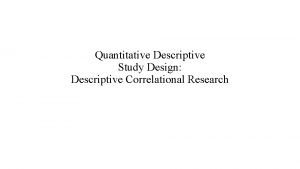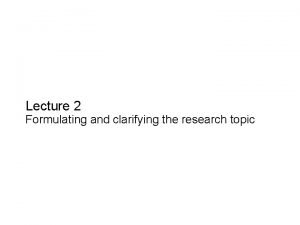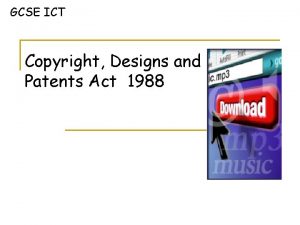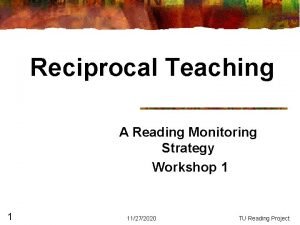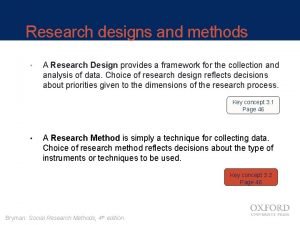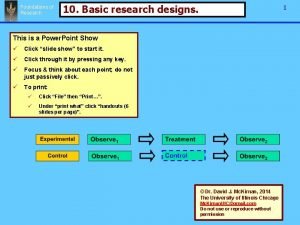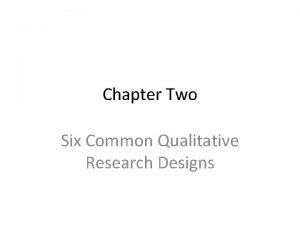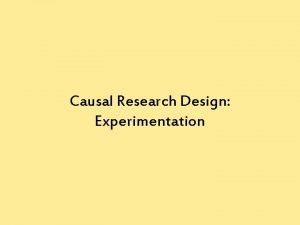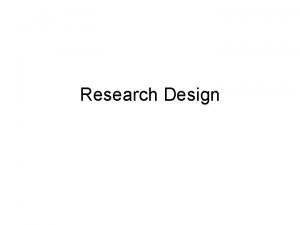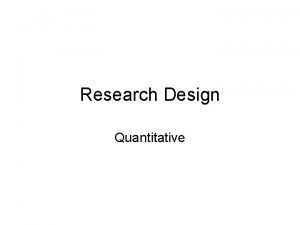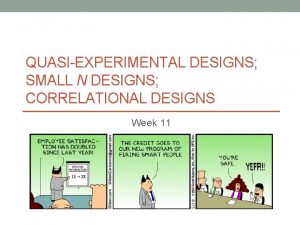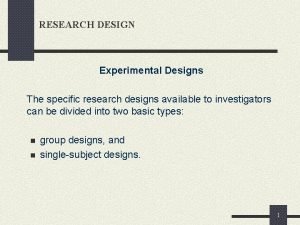Chapter 8 Clarifying Quantitative Research Designs Copyright 2011











































- Slides: 43

Chapter 8 Clarifying Quantitative Research Designs Copyright © 2011 by Saunders, an imprint of Elsevier Inc. 1

Research Design Blueprint or detailed plan for conducting a study Purpose, review of literature, and framework provide the basis for the design Copyright © 2011 by Saunders, an imprint of Elsevier Inc. 2

Study Purpose To describe variables To examine relationships To determine differences To test a treatment To provide a base of evidence for practice A combination of above Copyright © 2011 by Saunders, an imprint of Elsevier Inc. 3

Design Characteristics Maximizes control over factors to increase validity of the findings Guides the researcher in planning and implementing a study Not specific to a particular study, but linked to other steps of the research process Copyright © 2011 by Saunders, an imprint of Elsevier Inc. 4

Concepts Relevant to Design Causality Multicausality Probability Bias Control Manipulation Copyright © 2011 by Saunders, an imprint of Elsevier Inc. 5

Causality There is a cause-and-effect relationship between the variables. The simplest view is one independent variable causing a change in one dependent variable. Independent variable (X) causes Y (a change in the dependent variable). Copyright © 2011 by Saunders, an imprint of Elsevier Inc. 6

Multicausality There is a cause-and-effect relationship between interrelating variables. There are multiple independent variables causing a change in the dependent variable. Copyright © 2011 by Saunders, an imprint of Elsevier Inc. 7

Diagram of Causality and Multicausality Causality: A B Pressure Ulcer Multicausality: Years smoking High-fat diet Limited exercise Heart disease Copyright © 2011 by Saunders, an imprint of Elsevier Inc. 8

Probability The likelihood of accurately predicting an event Variations in variables occur. Is there relative causality? Therefore, what is the likelihood that a specific cause will result in a specific effect? Copyright © 2011 by Saunders, an imprint of Elsevier Inc. 9

Bias The slanting of findings away from the truth Bias distorts the findings. Research designs should be developed to reduce the likelihood of bias or to control for it. Copyright © 2011 by Saunders, an imprint of Elsevier Inc. 10

Potential Causes of Bias in Designs Researchers Components of the environment and/or setting Individual subjects and/or sample How groups were formed Measurement tools Data collection process Data and duration of study (maturation) Statistical tests and analysis interpretation Copyright © 2011 by Saunders, an imprint of Elsevier Inc. 11

Control Implemented throughout the design Improved accuracy of findings Increased control in quasi-experimental research Greatest in experimental research Copyright © 2011 by Saunders, an imprint of Elsevier Inc. 12

Manipulation Implementation of a treatment or intervention The independent variable is controlled. Must be careful to avoid introduction of bias into the study Usually done only in quasi-experimental and experimental designs Copyright © 2011 by Saunders, an imprint of Elsevier Inc. 13

Elements of a Strong Design Controlling environment: selection of study setting Controlling equivalence of subjects and groups Controlling treatment (Tx) Controlling measurement Controlling extraneous variables Copyright © 2011 by Saunders, an imprint of Elsevier Inc. 14

Critiquing a Study Design Was the type of design identified? Was the study design linked to the purpose and/or objectives, questions, or hypotheses? Were all variables manipulated or measured? Copyright © 2011 by Saunders, an imprint of Elsevier Inc. 15

Critiquing a Study Design (cont’d) If the study included a treatment, was it clearly described and consistently implemented? Were extraneous variables identified and controlled? What were threats to design validity in study? Copyright © 2011 by Saunders, an imprint of Elsevier Inc. 16

Critiquing a Study Design (cont’d) Was a pilot study performed? What was reason for pilot and the outcome? Ø Ø Ø Study feasibility Refine design or treatment Examine validity and reliability of measurement methods Copyright © 2011 by Saunders, an imprint of Elsevier Inc. 17

Critiquing a Study Design (cont’d) How adequate was the manipulation? What elements should have been manipulated to improve the validity of the findings? Based on your assessment of the adequacy of the design, how valid are the findings? Is there another reasonable (valid) explanation (rival hypothesis) for the study findings other than that proposed by the researcher? Copyright © 2011 by Saunders, an imprint of Elsevier Inc. 18

Critiquing a Study Design (cont’d) Identify elements controlled in the study. Identify possible sources of bias. Are there elements that could have been controlled to improve the study design? What elements of the design were manipulated and how were they manipulated? Copyright © 2011 by Saunders, an imprint of Elsevier Inc. 19

Types of Quantitative Research Designs Descriptive study designs Correlational study designs Quasi-experimental study designs Experimental study designs Copyright © 2011 by Saunders, an imprint of Elsevier Inc. 20

Diagramming the Design Clarifies variables to be measured or manipulated Indicates focus of study: description, relationships, differences, and/or testing a treatment Identifies data collection process: time for study, treatment implementation, measurement of variables Provides direction to data analysis Copyright © 2011 by Saunders, an imprint of Elsevier Inc. 21

Descriptive Study Designs Typical descriptive design Comparative descriptive design Case study design Copyright © 2011 by Saunders, an imprint of Elsevier Inc. 22

Typical Descriptive Design Most commonly used design Examines characteristics of a single sample Identifies phenomenon, variables, conceptual and operational definitions, and describes definitions Copyright © 2011 by Saunders, an imprint of Elsevier Inc. 23

Comparative Descriptive Design Examines differences in variables in two or more groups that occur naturally in a setting Results obtained from these analyses are frequently not generalizable to a population Copyright © 2011 by Saunders, an imprint of Elsevier Inc. 24

Case Study Design Exploration of single unit of study (i. e. , family, group, or community) Even though sample is small, number of variables studied is large. Design can be source of descriptive information to support or invalidate theories. It has potential to reveal important findings that can generate new hypotheses for testing. There is no control. Copyright © 2011 by Saunders, an imprint of Elsevier Inc. 25

Correlational Design Descriptive correlational design Predictive correlational design Model testing design Copyright © 2011 by Saunders, an imprint of Elsevier Inc. 26

Determining Type of Correlational Design Copyright © 2011 by Saunders, an imprint of Elsevier Inc. 27

Descriptive Correlational Design Describes variables and relationships between variables There is no attempt to control or manipulate the situation. Copyright © 2011 by Saunders, an imprint of Elsevier Inc. 28

Predictive Correlational Design Predicts value of one variable based on values obtained for other variables Independent and dependent variables are defined. Independent variables most effective in prediction are highly correlated with dependent variables Required development of theory-based mathematical hypothesis proposing variables expected to effectively predict dependent variable Copyright © 2011 by Saunders, an imprint of Elsevier Inc. 29

Model Testing Design Tests accuracy of hypothesized causal model (middle-range theory) All variables are relevant to the model being measured. A large, heterogeneous sample is required. All paths expressing relationships between concepts are identified. Copyright © 2011 by Saunders, an imprint of Elsevier Inc. 30

Advantages of Experimental Designs More controls: design and conduct of study Increased internal validity: decreased threats to design validity Fewer rival hypotheses Copyright © 2011 by Saunders, an imprint of Elsevier Inc. 31

Essential Elements of Experiments Random assignment of subjects to groups Researcher-controlled manipulation of independent variable 3. Researcher control of experimental situation and setting, including control/comparison group 4. Control of variance 1. 2. • • • Clearly spelled out sampling criteria Precisely defined independent variable Carefully measured dependent variable Copyright © 2011 by Saunders, an imprint of Elsevier Inc. 32

Quasi-experimental Design Untreated control group design with pretest and posttest Nonequivalent dependent variables design Removed-treatment design with pretest and posttest Copyright © 2011 by Saunders, an imprint of Elsevier Inc. 33

Advantages of Quasi-experimental Design More practical: ease of implementation More feasible: resources, subjects, time, setting More readily generalized: comparable to practice Copyright © 2011 by Saunders, an imprint of Elsevier Inc. 34

Study Groups in comparative descriptive studies Control group Comparison group Equivalent vs. nonequivalent groups Copyright © 2011 by Saunders, an imprint of Elsevier Inc. 35

Randomized Clinical Trial The design uses large number of subjects to test a treatment’s effect and compare results with a control group who did not receive the treatment. The subjects come from a reference population. Randomization of subjects is essential. Usually multiple geographic locations are used. Copyright © 2011 by Saunders, an imprint of Elsevier Inc. 36

Experimental Interventions should result in differences in posttest measures between the treatment and control or comparison groups. Intervention could be physiological, psychosocial, educational, or a combination. Nursing is developing a classification system for interventions. Copyright © 2011 by Saunders, an imprint of Elsevier Inc. 37

Critiquing Guidelines for Interventions Was the experimental intervention described in detail? Was justification from the literature provided for development of the intervention, and what is the current knowledge? Was a protocol developed to ensure consistent implementation of the treatment? Did the study report who implemented the treatment? Copyright © 2011 by Saunders, an imprint of Elsevier Inc. 38

Critiquing Guidelines for Interventions (cont’d) Was any control group intervention described? Was an intervention theory provided to explain conclusions? Copyright © 2011 by Saunders, an imprint of Elsevier Inc. 39

Mapping the Design O = Observation or measurement T = Treatment Copyright © 2011 by Saunders, an imprint of Elsevier Inc. 40

Two-Group Experimental Design Experimental group Control or comparison group Pretest Treatment Posttest O 1 T O 2 O 1 Copyright © 2011 by Saunders, an imprint of Elsevier Inc. O 2 41

Quasi-experiment with Several Posttests Pretest Treatment Experimental group Control or comparison group O 1 T 1 Mo 2 Mo 3 4 Mo Mo O 2 O 3 O 4 O 5 Copyright © 2011 by Saunders, an imprint of Elsevier Inc. 42

Replication Research Replication or repeating a study to confirm original findings Establishes credibility for the findings Provides support for theory development Encouraged for novice or new researchers Ø First clinical research project Copyright © 2011 by Saunders, an imprint of Elsevier Inc. 43
 Types of quantitative research designs
Types of quantitative research designs Characteristics of experimental research design
Characteristics of experimental research design Types of quantitative research designs
Types of quantitative research designs Types of quantitative research designs
Types of quantitative research designs Formulating and clarifying the research topic
Formulating and clarifying the research topic Clarifying the research question
Clarifying the research question Formulating and clarifying the research topic
Formulating and clarifying the research topic Formulating and clarifying the research topic
Formulating and clarifying the research topic Formulating and clarifying the research topic
Formulating and clarifying the research topic Formulating and clarifying the research topic
Formulating and clarifying the research topic Formulating and clarifying the research topic
Formulating and clarifying the research topic What is the copyright designs and patents act 1988
What is the copyright designs and patents act 1988 Copyright designs and patents act 1988
Copyright designs and patents act 1988 Chapter 10 qualitative research designs
Chapter 10 qualitative research designs Chapter 10 qualitative research designs book
Chapter 10 qualitative research designs book What are the characteristics of a qualitative research?
What are the characteristics of a qualitative research? Roles and responsibilities slide
Roles and responsibilities slide Spellers clarifying phrase
Spellers clarifying phrase A clarifying listener
A clarifying listener Monitor and clarify reading strategy
Monitor and clarify reading strategy Example of clarifying for comprehension
Example of clarifying for comprehension Parts of chapter 3 research methodology
Parts of chapter 3 research methodology Chapter 2 quantitative research
Chapter 2 quantitative research Types of study design
Types of study design Basic research designs
Basic research designs Types of qualitative research designs
Types of qualitative research designs Types of action research design
Types of action research design Exploratory vs descriptive vs causal research
Exploratory vs descriptive vs causal research What is causal research design
What is causal research design Conclusive research methodology
Conclusive research methodology What are the 5 types of non experimental research design
What are the 5 types of non experimental research design Types of research design exploratory
Types of research design exploratory Research designs
Research designs Conclusive research design
Conclusive research design Quasi-experimental research designs
Quasi-experimental research designs Quasi-experimental research designs
Quasi-experimental research designs Qualitative research is viewed in a holistic perspective.
Qualitative research is viewed in a holistic perspective. Quantitative research words
Quantitative research words Sampling methods in qualitative and quantitative research
Sampling methods in qualitative and quantitative research Appendix research sample
Appendix research sample Descriptive research design
Descriptive research design Descriptive research meaning
Descriptive research meaning Which of the following is an example of quantitative
Which of the following is an example of quantitative Group studied is smaller and not randomly selected
Group studied is smaller and not randomly selected


